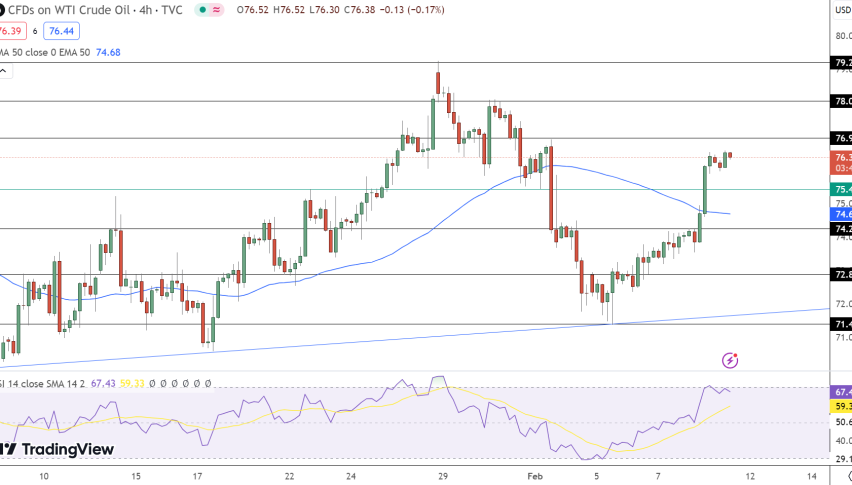WTI Crude Oil Nears $76.20 Amid Middle East Tensions & Surging Russian Exports
Despite heightened tensions in the Middle East, WTI crude oil prices experienced a downturn, retreating to $76.20. This decline halted


Despite heightened tensions in the Middle East, WTI crude oil prices experienced a downturn, retreating to $76.20. This decline halted its upward trajectory, primarily influenced by a robust US dollar buoyed by recent positive economic indicators.
An unexpected surge in Russia’s crude oil exports also exerted further downward pressure on global oil prices.
Potential Impact of Israeli Airstrikes on Crude Oil Prices
The ongoing conflict between Hamas and Israel continues unabated. Recent Israeli airstrikes targeted Rafah in Gaza, a refuge for many displaced individuals. The US cautioned against military incursions into the city to avert a humanitarian crisis.
At the same time, UN Secretary-General Antonio Guterres highlighted the dire situation of over a million civilians trapped in the conflict zone. Despite ongoing diplomatic efforts, Israel’s refusal of a Hamas-proposed ceasefire adds to the region’s instability.
This persistent conflict, particularly the Israeli airstrikes, raises concerns over potential disruptions in oil supply, which could lead to spikes in crude oil prices amid escalating geopolitical tensions.
Impact of Strong US Fuel Producer Performance on Crude Oil Prices
The last quarter saw impressive performances from leading US fuel companies, exceeding profit expectations due to efficient refining operations. With a forecast of increased global fuel demand, companies like Marathon Petroleum, Phillips 66, and Valero Energy anticipate higher earnings in 2024.
Despite facing industry challenges in 2023, their combined profits of $25.7 billion slightly dipped from the previous year but still outperformed other sectors in the stock market.
The strong performance and upbeat profit outlook of US fuel producers, along with anticipated growth in global demand, could help stabilize crude oil prices or even cause a slight decline, helped along by supply confidence.
Impact of Russian Export Challenges on Crude Oil Prices
Russia’s commitment to reducing crude oil exports, part of an agreement with other producers, faces hurdles due to drone attacks and refinery issues, leading to higher-than-planned exports for February.
Despite agreeing to production and export cuts, these challenges may hinder Russia’s ability to adhere to its commitments, affecting the global oil supply and market prices. Thus, Russia’s unexpected surge in crude oil exports, prompted by operational disruptions, might temporarily depress global crude oil prices as markets adjust to the surplus in supply.
WTI Crude Oil Price Forecast: Technical Outlook
WTI Crude Oil’s price slightly declined by 0.12%, standing at $76.38, reflecting cautious market sentiment. Despite the dip, the pivot point at $75.42 signals potential for rebound, with resistance levels waiting at $76.94, $78.05, and $79.21.

Support levels are deeper at $74.24, $72.89, and $71.41, suggesting a cushion against further declines. The Relative Strength Index (RSI) at 67 indicates near-overbought conditions, yet the cross above the 50-day Exponential Moving Average (EMA) of $74.68 suggests underlying bullish momentum.
This technical setup, backed by crossing the crucial 50 EMA, points to a positive outlook for WTI, provided it maintains above the $74.68 threshold, marking a bullish stance for the commodity in the near term.
- Check out our free forex signals
- Follow the top economic events on FX Leaders economic calendar
- Trade better, discover more Forex Trading Strategies
- Open a FREE Trading Account


